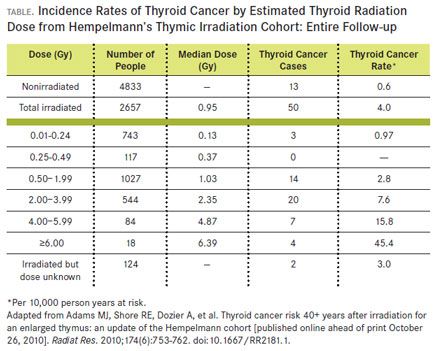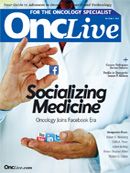Publication
Article
Oncology Live®
Childhood Radiation Exposure Risks Linger Beyond 50 Years
Author(s):
It has been more than half a century since radiation treatment was mistakenly deemed necessary to help infants with enlarged thymus glands avoid the risk of status lymphaticus and suffocation

It has been more than half a century since radiation treatment was mistakenly deemed necessary to help infants with enlarged thymus glands avoid the risk of status lymphaticus and suffocation.
Yet patients exposed to radiation in childhood as a result remain at a heightened risk of thyroid cancer nearly 58 years later, according to a team of researchers from the University of Rochester Medical Center, New York.
In fact, the overall risk for the study population was about 5.5 times higher than the general population, according to Michael Jacob Adams, MD, MPH, associate professor, Department of Community and Preventive Medicine, who led the study. (Radiat Res. 2010;174(6):753-762).

The study cohort likely is the longest-studied group of children exposed to radiation for medical reasons (as opposed to atomic bomb survivors) where there has been consistent follow-up, Adams said in an interview with OncLive.
The cohort includes 2657 people, most of whom received thymic radiation at aged ≤1 year over a 90-day period, and 4833 nonirradiated siblings. The radiated children were among a group that has been followed at various points since 1951, when Louis H. Hempelmann, MD, began looking at the incidence of cancer among children who had received the thymic treatments in the Rochester, New York, area between 1926 and 1957 and their untreated siblings.
In the latest study, researchers were able to gather data from 46.3% of the known surviving cohort members, which Adams said was a relatively low response rate and a key limitation. Investigators, however, did establish that even lower doses of therapeutic chest radiation (median 0.95 Gy, mean 1.29 Gy) in childhood are associated with a heightened cumulative risk of thyroid cancer up to a median follow-up of 57.5 years.
The results build upon knowledge about the risk of thyroid cancer for children exposed to radiation, and Adams believes the findings are notable even though radiation technology has changed so dramatically since the cohort group was treated. About 1 million computed tomography scans are performed annually on children 5 years or younger.
“If we do use radiation, we need to think about the lifelong impact and that people may need to be followed a little more closely,” Adams said. “Certainly, we want to use the least amount of dose and the fewest doses possible. And, especially in the youngest infants, we really have to think long and hard about using radiation, whenever there’s an alternative.”










